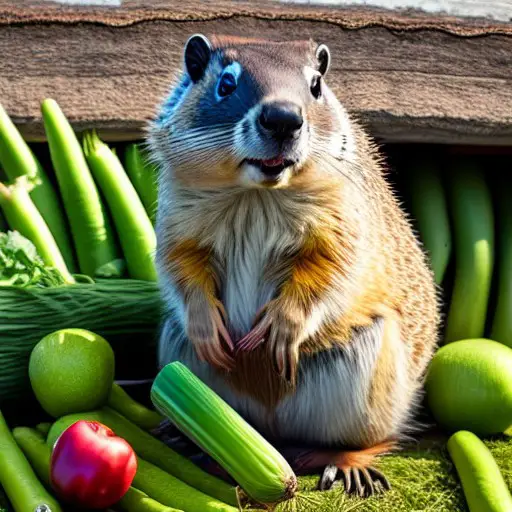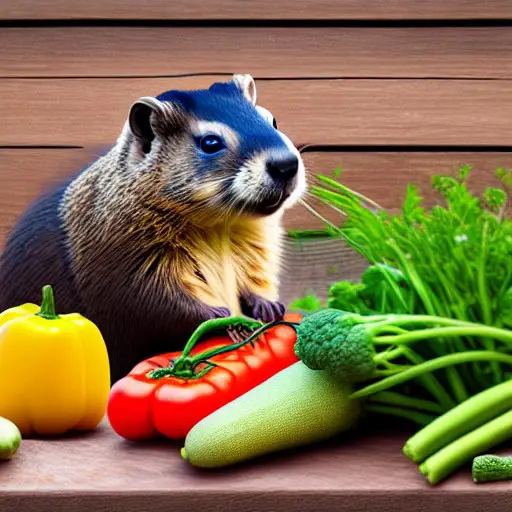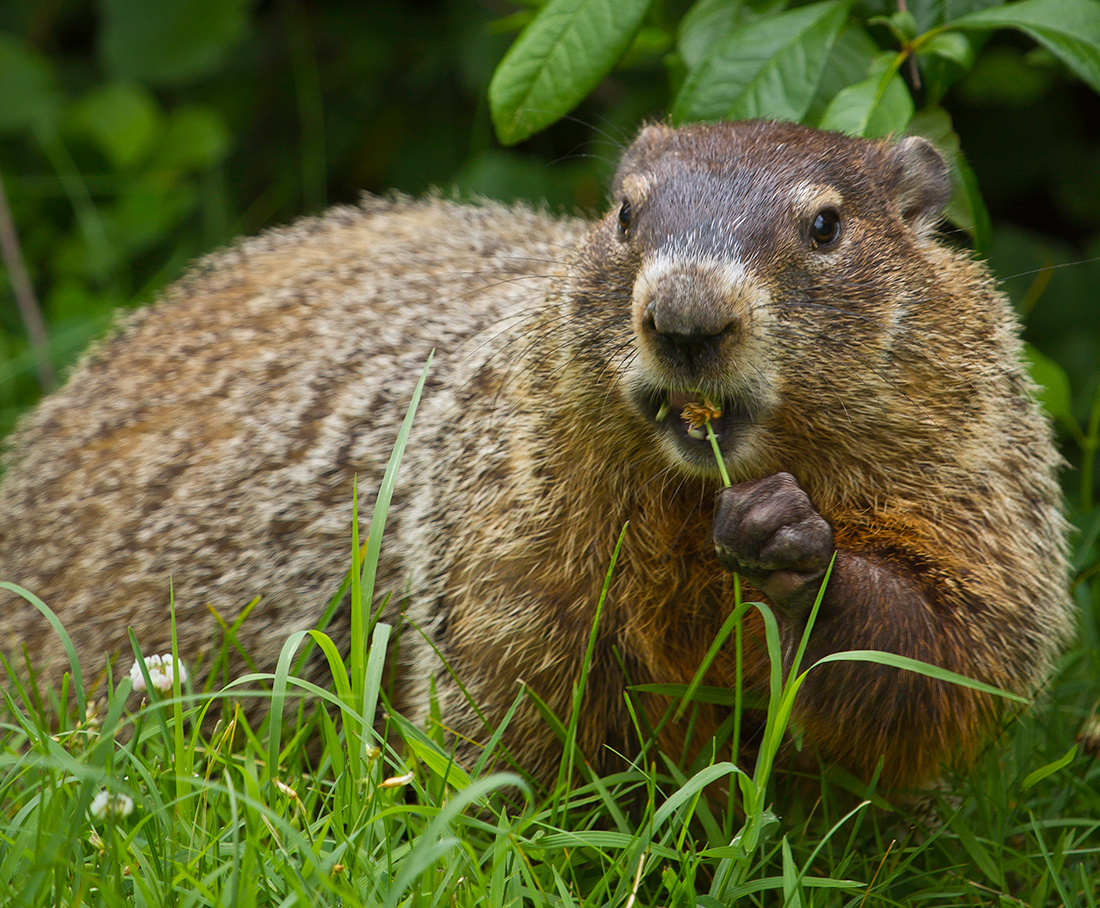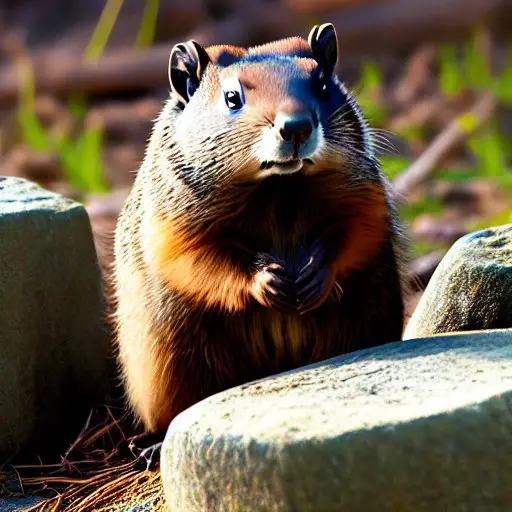As gardeners, we all know that groundhogs can be a nuisance when it comes to keeping our vegetable gardens safe. These furry little creatures are notorious for digging up our precious plants and devouring them in a matter of minutes.
So, what vegetables do groundhogs eat? It is important to know which plants are likely to attract them so that we can take necessary precautions to protect our gardens.
In this blog, we will explore the types of vegetables that groundhogs love to munch on and offer some tips on how to keep them away from your precious produce.
Contents
Groundhogs and Their Diet: A Brief Overview
Groundhogs, also known as woodchucks, are herbivorous animals that belong to the marmot family. They typically feed on plants, roots, fruits, and vegetables. In fact, groundhogs are notorious for their love of garden vegetables.
I wont go into much detail on the entirety of their diet here, as I already wrote a comprehensive post on the groundhog diet here. But I will focus on their taste of vegetables in this post.
In this brief overview of their diet, we explore the top vegetables that groundhogs are attracted to, as well as a comprehensive guide to growing groundhog-proof vegetables. We also discuss the vegetables that groundhogs tend to avoid and provide tips on how to grow and care for them.

It’s essential to understand the behavioral patterns of groundhogs to effectively coexist with them. Overeating vegetables by groundhogs can result in negative consequences, so we offer suggestions for natural ways to repel them from your property.
In conclusion, finding a balance between human and wildlife needs is paramount when dealing with groundhogs.
Top Vegetables That Attract Groundhogs
Groundhogs are notorious for raiding gardens and feasting on fruits and vegetables. If you’re a gardener, you know just how frustrating it can be to watch your hard work devoured by these pesky critters. To help keep your garden safe, we’ve put together a list of the top vegetables that attract groundhogs.
Some of their favorite vegetables include broccoli, cabbage, celery, lettuce, peas, and squash. While it might be tempting to give up on growing these delicious veggies altogether, there are steps you can take to protect your plants.
Here are 20 vegetables that are among their favorites:
- Carrots
- Lettuce
- Broccoli
- Cauliflower
- Brussels sprouts
- Cabbage
- Spinach
- Collard greens
- Kale
- Beet greens
- Swiss chard
- Peas
- Green beans
- Sweet potatoes
- Squash
- Zucchini
- Pumpkin
- Corn on the cob
- Radishes
- Turnips
In the next sections of this blog, we’ll cover groundhog-proof vegetables and understanding their behavioral patterns, as well as tips for coexisting with these animals in your backyard
Groundhog-Proof Vegetables: A Comprehensive Guide
If you’re a gardener, it’s essential to know which vegetables are less likely to attract groundhogs. In this section, we’ll provide you with a comprehensive guide to grow groundhog-proof vegetables. Groundhogs are known to avoid vegetables with strong smells, such as garlic and onions.

So, planting these vegetables alongside your other crops can act as a natural repellant. Additionally, groundhogs prefer leafy greens, so plants like peppers, eggplants, and tomatoes are less likely to catch their attention.
It’s recommended to fence off the perimeter of the garden, around 3-4 feet deep and buried underground to protect the roots of vegetables, as groundhogs can dig their way underneath.
By following these tips, gardeners can protect their vegetables from groundhogs without causing them any harm. After all, it’s all about finding the right balance between human needs and wildlife needs.
List of vegetables that groundhogs tend to avoid, including tips on how to grow and care for them
Groundhogs can be quite the menace for gardeners, often feasting on vegetables and ruining plants. However, there are some vegetables that they tend to avoid.
These include onion, garlic, leeks, and shallots. These vegetables have a strong scent that groundhogs dislike, making them a great option for gardeners looking to protect their crops. Additionally, planting these vegetables close to other susceptible plants can help deter groundhogs from approaching.
While groundhogs enjoy eating a wide variety of vegetables, there are some that they tend to avoid. Here are 10 vegetables that groundhogs typically do not like to eat:
- Garlic
- Onions
- Shallots
- Leeks
- Chives
- Hot peppers
- Fennel
- Asparagus
- Rhubarb
- Artichokes
It’s worth noting that while groundhogs generally do not like these vegetables, individual preferences can vary, and in some cases, groundhogs may eat these vegetables if they are particularly hungry or if there are no other options available.
Additionally, it’s always a good idea to protect your garden with fencing or other measures if you want to keep groundhogs from eating your crops.
Remember to take good care of these plants through proper watering, fertilization, and pruning techniques to get the most from your garden. With a little bit of planning and effort, these vegetables can help protect your garden from groundhog damage.
Understanding the Behavioral Patterns of Groundhogs
Groundhogs are fascinating creatures with complex behavioral patterns that are influenced by their diet and environment. Understanding their behavioral patterns is essential for effective coexistence with them. Groundhogs are known to be diurnal animals, meaning they are active during the day and rest at night.
They are also territorial but generally non-aggressive, preferring to retreat to their burrows when threatened. Groundhogs are also notorious for their love of vegetables, and this can pose a problem for gardeners.
By knowing what types of vegetables groundhogs tend to favor and how to protect one’s garden, one can peacefully coexist with these creatures.
It is important to note, however, that groundhogs play an essential role in their ecosystem, and their removal should only be a last resort. By understanding their behavioral patterns and implementing preventative measures, we can find the right balance between human and wildlife needs.

What Happens When Groundhogs Overeat Vegetables?
While groundhogs love munching on vegetables, overindulging in them can lead to health problems. Eating too much of certain vegetables, like those high in oxalic acid such as rhubarb and spinach, can cause the formation of kidney stones in groundhogs.
But most of all, it is just annoying for us backyard owners!
It’s important to keep in mind that groundhogs need a varied diet and should not rely solely on vegetables. Providing other food sources like grasses and grains can help balance their diet and prevent overeating.
Additionally, limiting the availability of certain vegetables or placing them in hard-to-reach areas can help prevent overindulging. Ultimately, finding the right balance between human needs and wildlife needs is key to coexisting peacefully with groundhogs.
Groundhogs in Your Backyard: Tips for Coexistence
Backyards can be a prime location for groundhogs, especially if there are gardens or farms nearby. It may be difficult to remove groundhogs completely, so finding ways to coexist with them is key. One tip is to fence off any vegetable gardens or fruit trees to prevent easy access for groundhogs.
Another option is to provide a designated feeding area with vegetables and greens, away from your garden or crops.
This can help redirect their attention and reduce the damage to your plants. It’s also important to keep an eye out for any signs of groundhog activity, such as burrows or chewed plants, and take action accordingly.
Finding the right balance between human and wildlife needs is essential when coexisting with groundhogs in your backyard.
Signs of Groundhog Damage and How to Fix Them
Groundhogs may be cute and harmless-looking, but their love for vegetable gardens can cause significant damage. Signs of groundhog damage include areas of vegetation that have been gnawed or completely eaten, as well as holes in the ground where groundhogs have dug their burrows.
To fix this problem, gardeners have a few options. One method is to set up a physical barrier such as a wire fence or a wall made of large rocks or concrete to block the groundhog’s access to the garden.
Another option is to use a trap to catch the groundhog and relocate it. If you choose this method, it’s important to check with your local wildlife officials for guidance on proper trapping and relocation techniques.
Additionally, implementing natural deterrents such as planting certain herbs or sprinkling Epsom salt around the garden can also help keep groundhogs at bay. By being proactive and taking steps to prevent damage, gardeners can coexist peacefully with these furry creatures.
Natural Ways to Repel Groundhogs from Your Property
In addition to understanding the behavior of groundhogs, it’s important to know how to naturally repel them from your property.
There are several things that can be done to prevent groundhogs from digging and eating stuff in your backyard. I will list some of the strategies below.
Also, see my recent post if you want a full list of my favorite methods to keep groundhogs and gophers away!

There are several ways to do this without causing harm to the animals. Some effective methods include using Epsom salts, aromatic herbs, and spices, scatter them around your garden or yard.
Castor oil is another natural repellent that can help keep groundhogs away. Fencing can also be an effective solution for protecting certain areas of your yard, such as your vegetable garden.
Additionally, sprinkling human hair around the yard can discourage the animals, as they find the scent threatening.
By utilizing these natural repellents, homeowners can coexist with groundhogs while also protecting their property.
1. Using ultrasonic sound
Groundhogs, like other bigger mammals that may invade your garden, tend to have very good hearing. This means that loud or consistent noises will scare them away or at least shorten their visits.
Check out my full buying guide for these ingenious ultrasonic repeller devices here!
One of my favorite technologies to keep pests away from my backyard is these cool solar-powered ultrasonic sound emitters that you can buy right from Amazon! In my experience, they really work, and the solar panels on top save you the time and money of changing batteries all the time.
They will also work against other rodents like gophers, mice, and rats!
2. Sprinkling natural repellents
Groundhogs may be scared off by using natural scents such as coyote urine or predator scents.
They may also cause them to leave if there is a combination of sounds being played from a radio. The sounds include the sound of barking dogs and coyotes.
You can sprinkle dog hair, cayenne pepper or strong enteric oils and other natural repellents around the garden to keep the groundhogs away.
See my complete list of humane ways to keep groundhogs away from your yard for more tips and tricks!
3. Fencing around the garden
You can also fence around your garden to keep groundhogs from entering the garden. It should be at least 3 feet deep and have a double row of fencing.
Groundhogs are good diggers so it has to go underground or they may find a way into the garden even with the fences in place!
4. Using live traps
You can use a live trap to capture groundhogs and move them to another area. Live trapping is currently the most humane way of groundhog control. Once you have removed all groundhogs from an area, it is important to ensure that they do not come back by using fencing or other barriers to block access.
You can also just buy a live trap, as the sturdy metal ones shown here:
To lure the groundhogs in, you can use one of the numerous favorite foods of groundhogs or an optimized extra attractive formula like this one to make the catch even quicker!
5. Using natural pesticides
There are pesticides or rodent toxins that can be used to kill groundhogs on your property. These may also affect other animals in the area so it is important to ensure that they are only sprayed on the targeted plants.
I do not recommend these, as I prefer more humane ways as described here. Also, anything that kills an animal will also harm humans to some degree, so go for a repellant rather than a toxin if you go the chemical route!
6. Using Scarecrows
You can use a scarecrow in your garden to keep groundhogs away. Groundhogs are afraid of novelty so time-sensitive or motion-activated scarecrows may also be effective in keeping them out of the garden.
7. Using Lights
Groundhogs are not strictly nocturnal animals but they are most active at low light so they do avoid areas with bright lights.
Motion-activated lights, sounds, and sprinklers may help prevent groundhogs from entering your yard.
Any blinking light will confuse and scare away groundhogs from your yard, especially if they are motion activated and sudden!
8. Motion-activated sprinklers
Like most animals, groundhogs hate surprises, and they will run away if suddenly sprayed with water. I like this solution because it is humane, simple, effective, and does not require much time to set up.
The Havahart 5277 is a motion-activated sprinkler that is activated by the movement of animals up to 25 feet away and sprays them with a harmless water jet, frightening them off and keeping them at bay.
The included metal stake makes it easy to install in your garden, and the sprinkler can be rotated 180 degrees for maximum coverage.
Conclusion: Finding the Right Balance between Human and Wildlife Needs
In conclusion, finding the right balance between human and wildlife needs is crucial when it comes to dealing with groundhogs. While these animals can cause damage to your backyard vegetable garden, it’s important to remember that they are an essential part of the ecosystem.
By understanding their behavior patterns and providing alternative sources of food, you can coexist peacefully with groundhogs. Planting groundhog-proof vegetables and using natural repellents can also help reduce damage to your property.
Ultimately, we must respect the needs of both humans and wildlife and work towards finding a harmonious solution. With a little effort and compromise, it is possible to strike a balance that benefits everyone involved.















